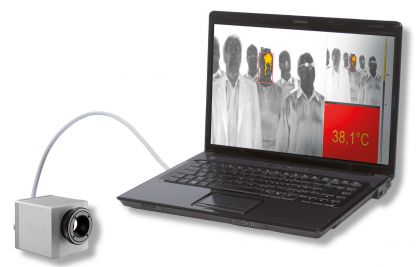Optris fever inspection system to prevent sick people flying

Africa for instance has around 60 airports so it’s an important international challenge to prevent sick people flying. For this purpose you can use Optris’s fever inspection system.
Virus epidemics like the Swine influenza in 2009/2010 and the Ebola virus disease in 2014 created a worldwide demand for suitable screening techniques allowing a fast non contact detection of travellers with potential fever.
The installation of the whole system including the infrared camera and its extensive software package is very easy. Also it can be re-located and set up in minimum time. The system is password-protected to prevent unauthorised changes.
Because of a reference radiator built into the infrared camera there’s an automatic and constant IR calibration of the camera itself. The temperature resolution of 0.1°C detects the smallest of temperature variances.
The system works discreetly. The software singles out the people whose skin temperature exceeds the predefined value. The visual alarm gives airport employees the possibility to identify and isolate suspects from their co-travellers so that a medical examination can be done discreetly.
If necessary the software offers the possibility to take automatically IR image snapshots when a person trips the alarm.
The system is available ex stock and can be delivered within one week. Scope of supply: USB camera incl. 1 lens, USB cable (1 m), table tripod,software package optris PI Connect, aluminum case. Price from 2,690 Euro including software.
Order contact:
Dipl.-Ing. Buelent Franke
info@optris.de
+49 30 500 197-42
Media Contact
All latest news from the category: Medical Engineering
The development of medical equipment, products and technical procedures is characterized by high research and development costs in a variety of fields related to the study of human medicine.
innovations-report provides informative and stimulating reports and articles on topics ranging from imaging processes, cell and tissue techniques, optical techniques, implants, orthopedic aids, clinical and medical office equipment, dialysis systems and x-ray/radiation monitoring devices to endoscopy, ultrasound, surgical techniques, and dental materials.
Newest articles

Why getting in touch with our ‘gerbil brain’ could help machines listen better
Macquarie University researchers have debunked a 75-year-old theory about how humans determine where sounds are coming from, and it could unlock the secret to creating a next generation of more…

Attosecond core-level spectroscopy reveals real-time molecular dynamics
Chemical reactions are complex mechanisms. Many different dynamical processes are involved, affecting both the electrons and the nucleus of the present atoms. Very often the strongly coupled electron and nuclear…

Free-forming organelles help plants adapt to climate change
Scientists uncover how plants “see” shades of light, temperature. Plants’ ability to sense light and temperature, and their ability to adapt to climate change, hinges on free-forming structures in their…





















